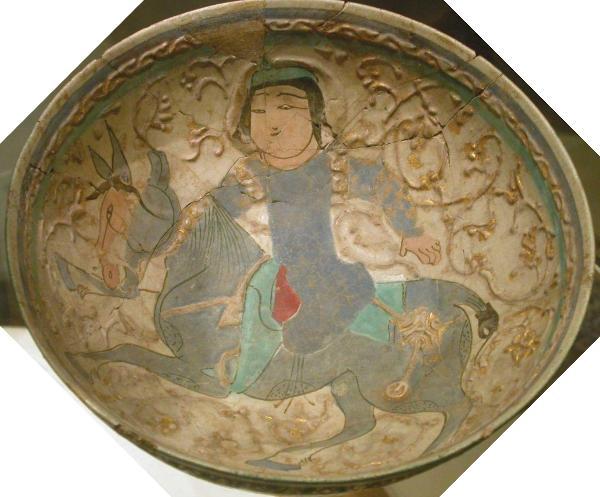Seljuq Bowl with Turkish horseman, 12th-13th centuries
 A larger image of this Seljuq Bowl with Turkish horseman, 12th-13th centuries. |
 A larger image of this Seljuq Bowl with Turkish horseman, 12th-13th centuries. |
Hegira 6th-7th / AD 12th-13th centuries, Seljuq
Glazed ceramic (mina'i)
National Museum of Oriental Art (Museo Nazionale d’Arte Orientale), Rome, Italy
This piece belongs to a type of ceramic known as mina’i, recognisable through the use of seven colours in its decoration. In antiquity, the main centre of production for mina’i ceramics was Kashan in central northern Iran. Source: Museum With No Frontiers
Luogo di conservazione: Museo Nazionale d'Arte Orientale 'Giuseppe Tucci'
Inventario: 5974
Materia e tecnica: Ceramica (impasto artificiale-fritta); decorazione policroma sopra invetriatura (mina’i); decorazione a rilievo applicata
Datazione: Fine XII - inizio XIII sec.; periodo selgiuchide
Provenienza: Prodotto in Iran
Dimensioni: Diametro 21.8 cm
Descrizione breve: La coppa è realizzata con la tecnica mina’i, tipica dei secoli XII e XIII, caratterizzata dall’uso di colori smaltati policromi (fino a sette colori differenti, haft rang) su invetriatura. I motivi decorativi di questa tipologia di ceramiche sono svariati, dalle figure singole alle fitte scene, riprese dal “Libro dei Re” di Firdusi, ai motivi floreali e geometrici. Quasi tutta la superficie interna di questa coppa è occupata dalla figura di un cavaliere, tre linee in blu, oro e turchese incorniciano il bordo dell’oggetto,mentre elaborate volute floreali a rilievo dipinte in oro riempiono lo sfondo della coppa e alcuni dettagli del vestito del cavaliere e dei finimenti del cavallo. Il soggetto di questo dipinto molto probabilmente fa parte dell’iconografia della vita del principe e della corte.
Place of conservation: 'Giuseppe Tucci' National Museum of Oriental Art
Inventory: 5974
Material and technique: Ceramics (fritware); polychrome decoration over glazing (mina'i); relief decoration applied
Dating: End of the 12th - beginning of the 13th century; Seljuk period
Provenance: Made in Iran
Dimensions: Diameter 21.8 cm
Short description: The cup is made with the Mina'i technique, typical of the twelfth and thirteenth centuries, characterized by the use of polychrome enamelled colours (up to seven different colors, haft rang) under glazing. The decorative motifs of this type of ceramics are varied, from single figures to dense scenes, taken from the "Book of Kings" [Shahnama] by Firdausi, to floral and geometric motifs. Almost all the inside surface of this cup is occupied by the figure of a horseman, three lines in blue, gold and turquoise frame the edge of the object, while elaborate relief floral scrolls painted in gold fill the background of the cup and some details of the dress of the horse rider and harness. The subject of this painting is very probably part of the iconography of the life of the prince and of the court.